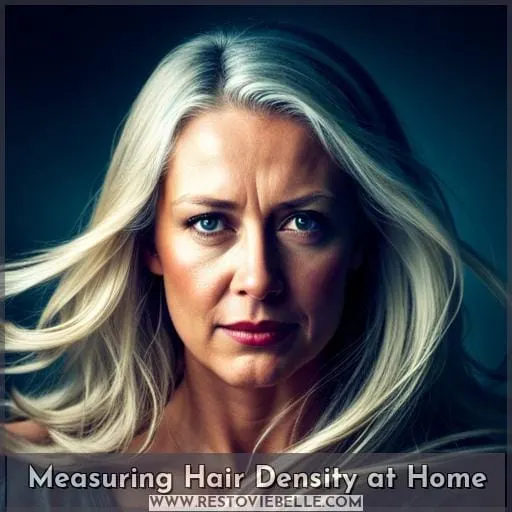This site is supported by our readers. We may earn a commission, at no cost to you, if you purchase through links.
 Are you curious about the number of strands on your scalp? Hair density refers to how many hairs per square inch there are, and it’s an important factor in determining what kind of hair products and styles will work best for you.
Are you curious about the number of strands on your scalp? Hair density refers to how many hairs per square inch there are, and it’s an important factor in determining what kind of hair products and styles will work best for you.
Knowing your hair’s density can also help improve its health — from finding the right shampoo to figuring out a suitable haircut. Let’s take a closer look at different types of hair densities, how they’re measured, why they matter, and some tips for taking care of them accordingly.
Table Of Contents
Key Takeaways
- Hair density refers to the amount of hair that grows per square inch on your head.
- Low-density hair has thinner strands and may benefit from volumizing products.
- Medium-density hair falls between 100 and 200 hairs per square inch on average.
- High-density hair has more than 300 hairs per square inch and may require heavier creams or gels.
What is Hair Density?
Your scalp can be an ever-changing canvas of individual strands, ranging from thin to thick depending on your genetics and lifestyle. Hair density refers to the amount of hair that grows per square inch on your head.
Types of hair density range from low (50-100 hairs/sq inch) to high (300-400 hairs/sq inch).
To measure it, you can use a ponytail test. Less than 2 inches indicates low density, 2-3 inches for medium density, and over 4 inches being high. You also need to take into account how visible your scalp is, as this indicates the amount of coverage or lack thereof that you have in terms of thickness or thinness in areas across your head.
Knowing what type you are helps determine which products will work best for styling. Volumizing products are ideal for those with lower densities, while thicker creams may help reduce bulk if yours is higher than average.
While not all factors affecting our locks may be in our control, it’s important we care for them according to their specific needs so they stay strong against environmental aggressors like sun exposure and pollution.
Types of Hair Density
There are three distinct types of hair density, so understanding yours is essential for creating a tailored haircare routine.
Low-density hair may be determined by visual inspection or measuring the circumference of a ponytail. It can range from 50 to 100 hairs per square inch and typically has thinner strands than those with high-density locks.
People who have low density should take care to avoid heavy products and opt instead for lighter volumizing styling agents that won’t weigh down their tresses.
On the other hand, medium-density hair usually falls between 100 and 200 hairs per square inch on average but varies greatly across ethnicity. This group would benefit from experimenting with different hairstyles as well as moisturizing treatments that prevent breakage without adding unnecessary bulk.
Finally, individuals blessed with thick manes often boast more than 300 hairs per square inch—the highest level of scalp coverage—and therefore require heavier creams or gels to control frizz while still allowing them plenty of body volume without excess weight dragging them down flatly against their head shape throughout the day.
No matter your particular type though, eating a nutritious diet rich in biotin intake alongside dietary nutrients like vitamin C, A, B vitamins along with iron & zinc will help you maximize your potential!
How to Determine Your Hair Density
Discovering your hair density is the first step to achieving healthy and beautiful hair. The ponytail test and scalp test are two methods you can use to accurately determine your type of hair density, whether it’s low, medium, or high.
The Ponytail Test
You can determine your hair density by performing the ponytail test. This involves measuring the circumference of a ponytail to identify whether you have low, medium, or high density. Hair density is determined by biological factors like ethnicity and age, as well as proper diet and nutrient intake.
It also differs from person to person. African descent individuals typically have the lowest hair densities, while Caucasians have the highest numbers of strands per square inch on their scalps. Knowing your hair type helps you choose appropriate products for styling choices that won’t lead to excessive breakage or loss in thickness over time.
The right style choices, coupled with proper nutrition, will ensure healthy locks no matter what its natural density may be!
The Scalp Test
The Scalp Test involves examining the scalp for visible signs of hair density. To measure your own, tilt your head back and part sections of your hair to look for any sparse or bald patches. Knowing how dense you are can help determine a good haircare routine as well as appropriate styling products that will work best with each individual’s unique hair type and texture.
People with high-density scalps may need heavier styling serums to ensure their curls don’t become too bulky, while people with low-density scalps should avoid heavy creams or butters which weigh down the strands further still.
Why Does Hair Density Matter?
Understanding your individual strands’ width and how many are present can be key to unlocking a confident and healthy look. Hair density matters because it directly affects the overall health of the hair, as well as its appearance.
Knowing your density helps you choose appropriate styling products that will nourish, protect, or add volume depending on what is best for you.
- Incorporating nutrients into your diet, such as biotin, vitamin B-12, and omega-3 fatty acids, promotes hair growth and thickness.
- Volumizing shampoos help reduce oiliness in low-density hair while adding texture to thin strands.
- Lightweight mousses help give medium-density locks body without weighing them down too much with product buildup over time.
- High porosity curls need heavier butters or oils combined with lighter conditioners to control frizz while moisturizing each strand from root to tip without leaving behind residue, which may weigh them down further if left uncleansed for prolonged periods of time.
- Hair masks provide extra hydration when used periodically between wash days. They also smooth out cuticles, making it easier for light reflections off each strand, resulting in shinier, more luscious-looking tresses!
No matter where one falls on the spectrum—whether their hairs are fine like silk threads or coarse like rope fibers—having knowledge about one’s particular type makes attaining desired looks achievable by understanding exactly what works best instead of taking potluck guesses at beauty stores, hoping something might work! Embracing natural textures creates freedom from feeling confined by trends due solely based on societal pressures—instead allowing self-expression through hairstyles tailored specifically towards personal needs and desires.
How to Care for Your Hair Based on Its Density
Understanding your hair density is key to taking care of it correctly. Whether you have low, medium, or high-density hair, there are ways to ensure you’re caring for it in the best way possible. Low-density hair requires lighter styling products, while those with higher densities should use heavier creams and lotions to manage their locks.
Medium density needs maintenance through hairstyles and experimentation with different products. Additionally, a healthy diet can help maximize potential when it comes to achieving fullness in all types of hair densities.
How to Care for Low-Density Hair
For those with low-density hair, volumizing products and hairstyles can help create the illusion of more strands. Lightweight styling agents, like mousses or foams, offer texture without weighing down the hair.
A scalp examination by a stylist can determine where your density needs to be addressed most effectively.
Hair nutrition is also important; biotin, vitamin C, and other essential nutrients are key for healthy growth.
Follicular unit transplant (FUT) or follicular unit extraction (FUE) are surgical options that address poor hair density as well, but best discussed with a professional trichologist first.
How to Care for Medium-Density Hair
For medium-density hair, experiment with different styling products and hairstyles to create the perfect balance of volume and texture. To maintain healthy locks, it’s important to take a good scalp care routine, including selecting appropriate products for your hair type.
Detangling curls can be a challenge due to densely packed strands, so use moisturizing conditioners and creams to loosen knots without damaging the delicate structure of the crown.
Diet and nutrition play an essential role in overall hair health, so make sure you’re consuming adequate amounts of vitamins A, B-5, and Omega 3 fatty acids for optimal density results.
- Take a good scalp care routine
- Select appropriate products for your hair type
- Use moisturizing conditioners and creams when detangling
How to Care for High-Density Hair
People with high-density hair may need heavier styling products and hairstyles that remove excess bulk to maintain their look. Try volumizing products and styling agents to create movement, while tackling the detangling challenge of highly dense curls.
Hair foams or frizz-reducing serums can add definition without weighing down your strands. Nutritional deficiencies can lead to thinning, so make sure you’re getting all the essential nutrients like biotin, protein, vitamins A & C for anti-breakage protection! For extra strength, try follicular unit extraction (FUE) or hair butters and oils applied at roots for a volume boost.
Measuring Hair Density at Home
You can easily measure your hair density at home, using the ponytail test or a scalp examination.
For example, if you do the ponytail test and your circumference is less than two inches, then you can conclude that you have low-density hair.
If it’s between two and three inches, then it’s medium-density.
Over four inches indicates high-density locks.
A scalp examination helps determine the visibility of individual strands in different areas of the head.
To maximize the potential for thicker tresses, incorporate nutrition tips into diet advice like getting enough vitamin D or incorporating biotin-rich foods into meals regularly.
Hair products should be tailored to suit each type. Lightweight volumizers work best with thin hair, while heavier creams may help reduce volume for highly dense scalps.
Follicular unit transplant (FUT) and follicular unit extraction (FUE) procedures are another option for those looking to increase their overall depth.
Embrace thick curls by detangling with good conditioner, remove excess bulk with heavy products when needed, add texture through mousses — whatever works best!
Knowing our own particular densities allows us to pick appropriate treatments that will bring out beautiful healthy manes every time!
FUT and FUE Transplant
Follicular unit transplant (FUT) and follicular unit extraction (FUE) are two hair transplantation methods that can address poor density, allowing you to restore a fuller look. These procedures involve transferring healthy hairs from an area of thicker growth to areas where the density is lower.
FUT involves removing a strip of skin with many tiny hairs, while FUE requires individual grafts being harvested one by one directly from the scalp. Both techniques have their pros and cons but ultimately aim for similar outcomes: more natural-looking, long-lasting results with minimal scarring or downtime afterward.
When considering either option, it’s important to understand your own hair type—thickness versus the number of strands—as well as nutrition advice specific for promoting healthier-looking locks before undergoing any surgery.
Knowing your hair density also helps in product selection and hairstyle options appropriate for fine or thick tresses alike.
Ultimately, understanding what hair density means taking into account all its parameters, including race, which affects the average amount per square inch, as well as the age factor, which decreases the overall number over time too.
Take a Holistic Approach to Hair Health
Taking a holistic approach to your hair health can help you maximize its potential and create the look you desire. Start by nourishing your body with nutrient-rich foods, like fruits, vegetables, proteins, complex carbs, and healthy fats.
Supplementing with vitamins B-5 and B-12, as well as omega 3 fatty acids, will also help promote thicker, healthier-looking hair. Additionally, caring for your scalp is essential. Shampoo regularly using sulfate-free products that won’t strip away natural oils from the scalp or dehydrate strands while cleansing it of build-up or pollutants from environmental stressors.
Volumizing products are beneficial in adding lift to low-density hair without weighing down medium/high-density strands, while thickening treatments provide extra conditioning benefits when paired with lightweight styling agents designed specifically for high dense locks, such as rich creams, gels, butters, foams, etc.
In order to maintain optimal results, focus on maintaining consistency in both diet and lifestyle habits, coupled with an individualized care regimen tailored towards each unique head of tresses, whether thin, medium, or thick!
Frequently Asked Questions (FAQs)
What are the best styling products for each type of hair density?
For low-density hair, opt for lightweight volumizing products. Medium density requires maintenance and experimentation with hairstyles and products.
How can I maximize my hair density potential?
Maximize your hair density potential by consuming a nutritious diet with sufficient nutrients and experimenting with various volumizing, thickening, and styling products tailored to your hair type.
What nutrients are important for hair growth?
Eating a balanced diet with essential nutrients like biotin, protein, vitamins C and A, B vitamins, vitamin D and E, iron, and zinc can help promote hair growth.
Are there any other methods of hair transplantation than FUT and FUE?
Yes, there are other methods of hair transplantation. Platelet-rich plasma (PRP), scalp micropigmentation, and laser therapy can all be used to help restore hair density. PRP involves injecting your own blood platelets into the scalp and stimulating growth factors for thicker strands; micropigmentation replicates follicles using tiny ink deposits, while laser therapy helps promote circulation around thinning areas.
Does hair density decrease with age?
Yes, hair density can decrease with age. As we age, our scalp’s ability to produce strands of hair decreases, and the number of hairs per square inch may diminish. To maintain healthy hair density as you age, it is important to eat a nutritious diet and use volumizing products for low-density locks or styling agents that reduce bulk for high-density types.
Conclusion
From thin to thick, hair density varies from person to person, but understanding what type of hair density you have and how to care for it can make a huge difference in how you look and feel. Knowing your hair density is key to finding the right products and treatments to help you achieve your desired look.
Low density hair needs lightweight volumizing products, while high density hair can benefit from heavier products and styling techniques that remove excess bulk. A holistic approach to hair care, including a balanced diet and clinically proven products, can help maximize your hair’s potential.
So, what is hair density? It’s the number of strands of hair per square inch of the scalp and can vary by race, ethnicity, and age. Embrace your hair density and find the right products and styling techniques to help you look and feel your best.












